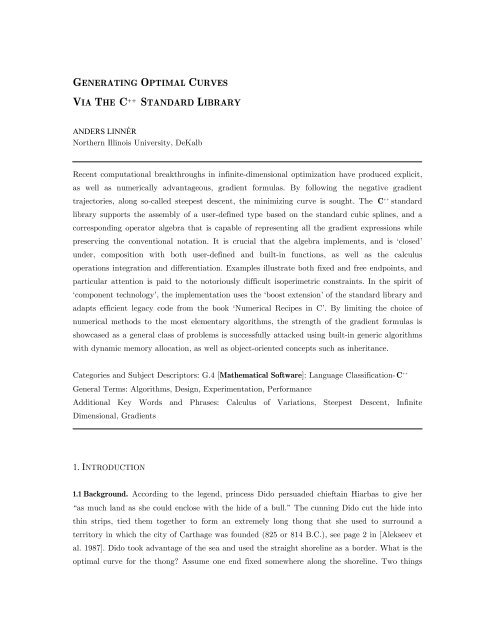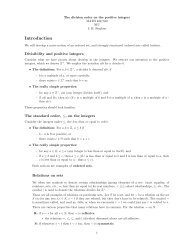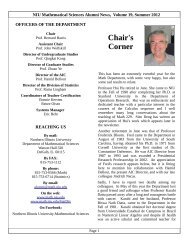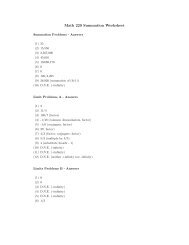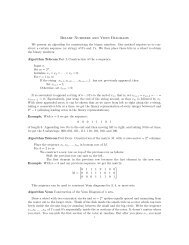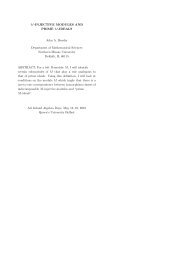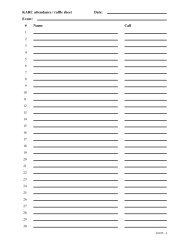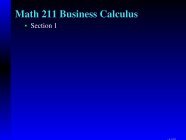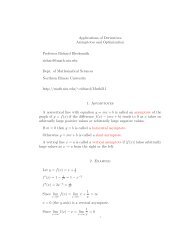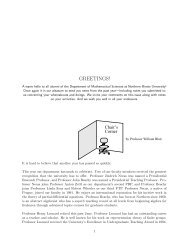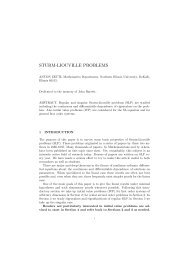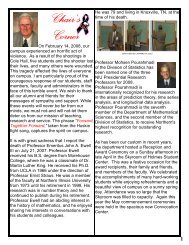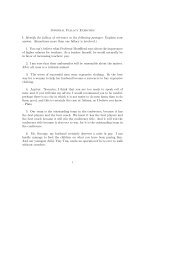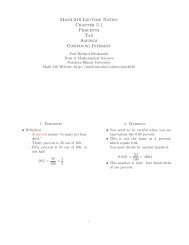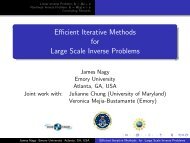Generating Optimal Curves via the C++ Standard Library
Generating Optimal Curves via the C++ Standard Library
Generating Optimal Curves via the C++ Standard Library
Create successful ePaper yourself
Turn your PDF publications into a flip-book with our unique Google optimized e-Paper software.
GENERATING OPTIMAL CURVES<br />
++<br />
VIA THE C STANDARD LIBRARY<br />
ANDERS LINNÉR<br />
Nor<strong>the</strong>rn Illinois University, DeKalb<br />
Recent computational breakthroughs in infinite-dimensional optimization have produced explicit,<br />
as well as numerically advantageous, gradient formulas. By following <strong>the</strong> negative gradient<br />
trajectories, along so-called steepest descent, <strong>the</strong> minimizing curve is sought. The C<br />
++<br />
standard<br />
library supports <strong>the</strong> assembly of a user-defined type based on <strong>the</strong> standard cubic splines, and a<br />
corresponding operator algebra that is capable of representing all <strong>the</strong> gradient expressions while<br />
preserving <strong>the</strong> conventional notation. It is crucial that <strong>the</strong> algebra implements, and is ‘closed’<br />
under, composition with both user-defined and built-in functions, as well as <strong>the</strong> calculus<br />
operations integration and differentiation. Examples illustrate both fixed and free endpoints, and<br />
particular attention is paid to <strong>the</strong> notoriously difficult isoperimetric constraints. In <strong>the</strong> spirit of<br />
‘component technology’, <strong>the</strong> implementation uses <strong>the</strong> ‘boost extension’ of <strong>the</strong> standard library and<br />
adapts efficient legacy code from <strong>the</strong> book ‘Numerical Recipes in C’. By limiting <strong>the</strong> choice of<br />
numerical methods to <strong>the</strong> most elementary algorithms, <strong>the</strong> strength of <strong>the</strong> gradient formulas is<br />
showcased as a general class of problems is successfully attacked using built-in generic algorithms<br />
with dynamic memory allocation, as well as object-oriented concepts such as inheritance.<br />
++<br />
Categories and Subject Descriptors: G.4 [Ma<strong>the</strong>matical Software]: Language Classification- C<br />
General Terms: Algorithms, Design, Experimentation, Performance<br />
Additional Key Words and Phrases: Calculus of Variations, Steepest Descent, Infinite<br />
Dimensional, Gradients<br />
1. INTRODUCTION<br />
1.1 Background. According to <strong>the</strong> legend, princess Dido persuaded chieftain Hiarbas to give her<br />
“as much land as she could enclose with <strong>the</strong> hide of a bull.” The cunning Dido cut <strong>the</strong> hide into<br />
thin strips, tied <strong>the</strong>m toge<strong>the</strong>r to form an extremely long thong that she used to surround a<br />
territory in which <strong>the</strong> city of Carthage was founded (825 or 814 B.C.), see page 2 in [Alekseev et<br />
al. 1987]. Dido took advantage of <strong>the</strong> sea and used <strong>the</strong> straight shoreline as a border. What is <strong>the</strong><br />
optimal curve for <strong>the</strong> thong Assume one end fixed somewhere along <strong>the</strong> shoreline. Two things
2<br />
ANDERS LINNÉR<br />
must be determined, where should <strong>the</strong> final point of <strong>the</strong> thong be placed and what shape should<br />
<strong>the</strong> thong have between its endpoints<br />
1.2 Isoperimetric constraints. This legend offers one of <strong>the</strong> earliest examples of a problem where<br />
<strong>the</strong> optimal curve is to be determined. Dido’s problem illustrates <strong>the</strong> presence of side conditions<br />
since <strong>the</strong> length of <strong>the</strong> competing curves is fixed and <strong>the</strong> endpoints must be on <strong>the</strong> shoreline.<br />
There is of course a limitless collection of problems involving optimal curves subject to side<br />
conditions. The purpose of <strong>the</strong> present paper is to present an implementation that efficiently<br />
‘improves’ <strong>the</strong> shape of a given initial curve until <strong>the</strong> optimal curve is reached. The process is<br />
applicable to <strong>the</strong> general case, and all side conditions are satisfied at each stage. Any side<br />
condition that can be expressed as <strong>the</strong> demand that a certain integral takes on a fixed value is<br />
referred to as an isoperimetric constraint. Fixing <strong>the</strong> length of <strong>the</strong> competing curves is an example<br />
of an isoperimetric constraint. The implementation allows up to two isoperimetric constraints and<br />
any combination of fixed or free endpoints. The software is designed to readily extend to cases<br />
with more than two isoperimetric constraints, or when a point o<strong>the</strong>r than an endpoint is fixed, or<br />
if periodic boundary conditions are imposed, or any combination of <strong>the</strong> above.<br />
1.3 Infinite-dimensional domain with curvature. It is important to recognize that <strong>the</strong> presence of<br />
isoperimetric constraints introduces an essential non-linearity. The objective and <strong>the</strong> isoperimetric<br />
constraints typically involve integrals with integrands depending on derivatives of <strong>the</strong> function<br />
representing <strong>the</strong> curve. The form of <strong>the</strong> integrand suggests a choice of a linear function space of<br />
sufficiently smooth functions. To increase <strong>the</strong> likelihood that <strong>the</strong>re is an optimal curve, <strong>the</strong><br />
selected function space is <strong>the</strong> least restrictive as far as assumptions on smoothness. The subset of<br />
functions that satisfy an isoperimetric constraint inside <strong>the</strong> selected function space will nei<strong>the</strong>r be<br />
linear nor flat.<br />
1.4 Inner products. Geometric methods are made accessible once an inner product is defined on<br />
<strong>the</strong> function space. There is some freedom in this choice and <strong>the</strong> present paper discusses three<br />
different inner products. The corresponding so-called Sobolev spaces have <strong>the</strong> same properties as<br />
far as convergence is concerned, but <strong>the</strong>y differ in subtle ways geometrically. The subset of curves<br />
satisfying a given isoperimetric constraint is expected to have a well-defined one-dimensional<br />
normal space inside <strong>the</strong> linear space of all curves. The infinite-dimensional linear space of<br />
functions perpendicular to this space is <strong>the</strong> so-called tangent space. Different curves typically<br />
correspond to different tangent spaces. The constrained curves form an infinite-dimensional ‘level<br />
surface’ inside <strong>the</strong> space of all curves. When two isoperimetric constraints are present, it is often<br />
<strong>the</strong> case that <strong>the</strong> corresponding level surfaces intersect ‘transversally’ and <strong>the</strong> normal space to <strong>the</strong><br />
intersection manifold is two-dimensional. The corresponding orthogonal tangent space is of course<br />
still infinite-dimensional.
++<br />
GENERATING OPTIMAL CURVES VIA THE C STANDARD LIBRARY 3<br />
1.5 Derivatives and gradients. The next step is to compute <strong>the</strong> so-called Gateaux derivative (or<br />
directional derivative) of <strong>the</strong> non-linear objective and constraint functionals. These derivatives are<br />
linear functionals and <strong>the</strong> Riesz <strong>the</strong>orem guarantees that <strong>the</strong>re is a function, <strong>the</strong> gradient, which<br />
represents <strong>the</strong> Gateaux derivative. If <strong>the</strong> level surfaces are regular and <strong>the</strong> intersections are<br />
transversal, <strong>the</strong>n he gradients of <strong>the</strong> constraints are in <strong>the</strong> normal space. It follows that <strong>the</strong><br />
gradient of <strong>the</strong> objective can be projected onto <strong>the</strong> tangent space. There is now a curve, <strong>the</strong><br />
gradient trajectory, inside <strong>the</strong> infinite-dimensional manifold with <strong>the</strong> property that its velocity<br />
vector is parallel to <strong>the</strong> projected gradient. The implementation presented here generates points<br />
along <strong>the</strong> gradient trajectory. These points correspond to ever improving curves that satisfy <strong>the</strong><br />
constraints of <strong>the</strong> original problem.<br />
1.6 Motivation. Although <strong>the</strong> classical problems, such as Dido’s, are interesting in <strong>the</strong>ir own<br />
right, <strong>the</strong>y are not <strong>the</strong> main motivation behind <strong>the</strong> development of this code. The real interest is<br />
in problems of periodic orbits that require ‘floating’ boundary conditions constrained to infinitedimensional<br />
manifolds that are not flat. In <strong>the</strong>se problems <strong>the</strong> solution is not given by some<br />
traditional boundary-value problem such as <strong>the</strong> one related to <strong>the</strong> Euler-Lagrange equation. As<br />
an example consider a distorted sphere E (for Earth). A geodesic on E is a curve x such that if<br />
a particle travels along x with constant speed, <strong>the</strong>n its acceleration vector is at all times normal<br />
to E . Given a tangent vector v at p in E <strong>the</strong>re is a geodesic emanating from p with initial<br />
direction v . This geodesic extends indefinitely producing a curve that winds around E . If <strong>the</strong><br />
geodesic returns to p and its direction at that instant is v , <strong>the</strong>n it is said to be periodic. In <strong>the</strong><br />
case of <strong>the</strong> standard round sphere each geodesic is periodic, and in fact a great circle traversed<br />
repeatedly. For a distorted sphere it is not clear that <strong>the</strong>re are any periodic geodesics.<br />
1.7 Recent progress. The work of many ma<strong>the</strong>maticians over several hundred years culminated in<br />
<strong>the</strong> 1990’s with <strong>the</strong> papers [Franks 1992; Bangert 1993; Hingston 1993]. It is now known with<br />
certainty that any distorted sphere has an infinite number of geometrically distinct periodic<br />
geodesic. Moreover, if n( L ) is <strong>the</strong> number of periodic geodesics of length less than or equal to L ,<br />
<strong>the</strong>n n( L ) grows at least as fast as <strong>the</strong> prime numbers. It is possible to generalize <strong>the</strong> notion of<br />
geodesics to arbitrary so-called Riemannian manifolds. In this generalized setting <strong>the</strong> Newtonian<br />
evolution of a mechanical system corresponds directly to a geodesic in <strong>the</strong> appropriate<br />
Riemannian manifold. Periodic orbits that are sought in <strong>the</strong> famous celestial three-body problem<br />
thus correspond to periodic geodesics.<br />
1.8 Current research. To <strong>the</strong> best of <strong>the</strong> author’s knowledge, nobody has successfully implemented<br />
an algorithm capable of generating general periodic geodesics. One difficulty is <strong>the</strong> fact that <strong>the</strong>re<br />
is no guarantee that through a given point p with given direction v <strong>the</strong>re is a periodic geodesic.<br />
It follows that <strong>the</strong> implementation must handle ‘floating constraints’ where p and v are allowed<br />
to vary keeping endpoints in agreement as in x( 0) = x( 1)<br />
= p and x′ ( 0) = x′<br />
( 1)<br />
= v . This has
4<br />
ANDERS LINNÉR<br />
turned out to be a considerable challenge. A second source of difficulty is <strong>the</strong> tri<strong>via</strong>l fundamental<br />
group of <strong>the</strong> sphere. Although it is possible to find two distinct periodic geodesics in a torus by<br />
shrinking a pair of suitable closed curves, this approach will not work in a sphere. A third<br />
difficulty is <strong>the</strong> available freedom in <strong>the</strong> parameterization of <strong>the</strong> curve. Moreover, for periodic<br />
orbits <strong>the</strong>re is also a rotation that leaves <strong>the</strong> curve invariant. The methodology of projected<br />
gradients combined with steepest descent adapts very well to <strong>the</strong>se circumstances. Since <strong>the</strong><br />
steepest descent takes place along a curved infinite-dimensional manifold, Newton’s method is not<br />
available as an alternative.<br />
1.9 Notation. Let X be a space of curves and consider functions F : X → R . The concern of this<br />
paper is <strong>the</strong> search for ˆx ∈ X with <strong>the</strong> property that F( xˆ<br />
) ≤ F( x)<br />
for all x ∈ X . The examples<br />
are drawn from <strong>the</strong> Calculus of Variations, so <strong>the</strong> space X is some subset of sufficiently smooth<br />
functions defined on <strong>the</strong> closed interval [ 0,1 ]. Let x = dx/<br />
dt be <strong>the</strong> derivative and define<br />
1<br />
( ) ( ( ) ( ))<br />
F x = ∫ f t, x t , x t dt ,<br />
3<br />
0<br />
where f : R → R is a given function. It is often assumed that <strong>the</strong> endpoints are fixed so that<br />
x( 0)<br />
= x0<br />
and x( 1)<br />
= x1<br />
for some specified x , x ∈ R . To expose potential candidates for ˆx<br />
0 1<br />
<strong>the</strong> conventional approach utilizes <strong>the</strong> Euler-Lagrange equation<br />
d ∂f ∂f<br />
( tx , ( t) , x( t)<br />
) = ( tx , ( t) , x( t)<br />
).<br />
dt ∂x<br />
∂x<br />
Here ∂f<br />
/ ∂ x represents <strong>the</strong> partial derivative of f with respect to its second variable, and<br />
∂f<br />
/ ∂ x <strong>the</strong> partial derivative with respect to its third variable. This ordinary differential<br />
equation toge<strong>the</strong>r with <strong>the</strong> prescribed boundary conditions is an example of <strong>the</strong> classical<br />
boundary value problem. The basic numerical method for this typically nonlinear problem is <strong>the</strong><br />
so-called ‘shooting method’ [Conte et al. 1980; Burden et al. 1985; Flowers 1995]. For a more<br />
comprehensive overview, including <strong>the</strong> finite element method, consult <strong>the</strong> books [Prenter 1975;<br />
Glowinski 1984, Nocedal et al. 1999]. The endpoint constraints cause next to no harm since <strong>the</strong><br />
corresponding domain of functions is at worst a translated linear space. In contrast, suppose<br />
X = G −1 ( 0)<br />
for some functional G : H → R of <strong>the</strong> form<br />
1<br />
( ) ( ( ) ( ))<br />
G x = ∫ g t, x t , x t dt ,<br />
0<br />
defined on some suitable Hilbert space H , and with g : R → R a given function. Typically, <strong>the</strong><br />
domain X is not ‘flat’, which leads to considerable complications. In <strong>the</strong> classical <strong>the</strong>ory,<br />
Lagrange multipliers are introduced to deal with this kind of ‘isoperimetric constraint’.<br />
Algorithms, such as <strong>the</strong> shooting method, are not designed to deal with unknown parameters like<br />
<strong>the</strong> multipliers. Line-searches are not expected to yield points in X . Alternative methods must be<br />
developed and <strong>the</strong> present paper explores one promising approach.<br />
3
++<br />
GENERATING OPTIMAL CURVES VIA THE C STANDARD LIBRARY 5<br />
1.10 Purpose and design issues. The paper presents <strong>the</strong> implementation of a general-purpose<br />
algorithm designed to at least handle all <strong>the</strong> standard problems in <strong>the</strong> elementary Calculus of<br />
Variations. The algorithm takes advantage of recent computational breakthroughs in infinite<br />
dimensional calculus [Linnér 2000]. There are now ‘explicit’ and ‘numerically friendly’ gradient<br />
formulas in terms of a certain Euler operator and <strong>the</strong> ‘Work’ functional. Flexibility in <strong>the</strong> choice<br />
of inner product in <strong>the</strong> Hilbert space is also permitted. Perhaps surprisingly, only very elementary<br />
numerical methods are sufficient as building blocks as <strong>the</strong> algorithm is assembled. The gradient<br />
formulas involve a mix of integrals, derivatives, compositions with special functions, and <strong>the</strong> usual<br />
algebraic operations. The gradient formulas are somewhat complicated and each isoperimetric<br />
constraint introduces its own gradient. The presence of endpoint constraints changes <strong>the</strong> gradient<br />
formulas and so does a change of <strong>the</strong> inner product in <strong>the</strong> function space. Given this multitude of<br />
different formulas, it is obviously desirable that all ma<strong>the</strong>matical expressions are represented by<br />
code that mimics <strong>the</strong> original expressions and thus facilitating error-free translations. The pursuit<br />
of <strong>the</strong> infinite time limit along <strong>the</strong> negative gradient trajectories necessitates very efficient code.<br />
1.11 Programming language. The adoption of a C ++ standard in 1997 [Stroustrup 1997] and its<br />
++<br />
incorporation of most parts of <strong>the</strong> <strong>Standard</strong> Template <strong>Library</strong> [Stepanov-Lee 1995] makes C a<br />
very attractive choice. The code is easily ported and concerns about computational speed are at<br />
<strong>the</strong> core of <strong>the</strong> design of <strong>the</strong> STL. Specifically, <strong>the</strong> C ++ standard library supports a flexible<br />
representation of <strong>the</strong> functions in <strong>the</strong> infinite-dimensional space using dynamic memory allocation.<br />
++<br />
The C operator feature is essential to preserve standard ma<strong>the</strong>matical notation. Object-oriented<br />
‘inheritance’ combine with <strong>the</strong> ‘boost extension’ [http://www.boost.org; Josuttis 1999] to supply<br />
<strong>the</strong> necessary algebra with minimal coding. It is shown how both built-in functions and userdefined<br />
functions can be represented as function objects capable of proper interaction with <strong>the</strong><br />
discrete representation of <strong>the</strong> target functions. By demanding that all operations return an object<br />
of <strong>the</strong> same type, a computationally ‘closed’ framework is created. The gradient formulas are<br />
readily expressed in this framework, and steepest descent algorithms are easy to implement. The<br />
target functions are represented by cubic splines and implemented by modernizing and extending<br />
code in Numerical Recipes in C [Press et al. 1992].<br />
1.12 Fundamental difficulty. Recall that <strong>the</strong> steepest descent is <strong>the</strong> flow along <strong>the</strong> trajectories of<br />
<strong>the</strong> negative gradient vector field. In all but <strong>the</strong> simplest cases this flow is not known explicitly.<br />
All numerical algorithms will suffer from an irreversible loss of information at <strong>the</strong> start of <strong>the</strong><br />
descent in <strong>the</strong> infinite dimensional case. The initial point is a curve that can only be represented<br />
by a finite number of points. The flow subsequently acts on <strong>the</strong> discrete representation and this<br />
severely limits <strong>the</strong> number of applicable numerical tools during <strong>the</strong> descent. To deal with this<br />
difficulty, curves and gradients are here represented as instances of a C ++ class S (S for spline)<br />
with <strong>the</strong> following capabilities. S is derived from <strong>the</strong> ‘boost extension’ to give it all <strong>the</strong> usual<br />
algebraic operations. In addition, S has integral and derivative member functions that produce
6<br />
ANDERS LINNÉR<br />
objects of class S. S has a friend FunctionObject to permit composition with library functions and userdefined<br />
functions. The ability to compose with functions and still have an object of class S is<br />
crucial when expressing <strong>the</strong> gradients. S has a Show() method that displays <strong>the</strong> values at all <strong>the</strong><br />
sample points, and a Save() method to save <strong>the</strong> points and <strong>the</strong> values in a file.<br />
1.13 Organization. Section 2 introduces eight examples in increasing order of difficulty. The<br />
following table indicates if <strong>the</strong> corresponding solutions are known explicitly, implicitly or in terms<br />
of special functions:<br />
example number 1 2 3 4 5 6 7 8<br />
isoperimetric constraints 0 0 0 0 0 1 1 2<br />
number of free ends 0 0 0 0 1 0 1 2<br />
tri<strong>via</strong>l explicit solution <br />
implicit/special functions <br />
Each example is illustrated by computer graphics. The two question marks indicate that <strong>the</strong><br />
author is unaware of any rigorous derivation of <strong>the</strong>se solutions in ei<strong>the</strong>r implicit form or in terms<br />
of special functions. To use <strong>the</strong> implementation <strong>the</strong> user supplies a file where <strong>the</strong> types of<br />
constraints are indicated. For each functional <strong>the</strong> integrand and its partial derivatives must be<br />
coded, and an initial curve that satisfies all <strong>the</strong> constraints is coded as well. The gradient<br />
formulas are introduced in Section 3, and <strong>the</strong>re is also a brief discussion of <strong>the</strong> influence of <strong>the</strong><br />
choice of metric on <strong>the</strong> steepest descent in <strong>the</strong> space of curves. Section 3 shows how to deal with<br />
isoperimetric constraints. Finally, <strong>the</strong> spline class S is presented in Section 4 toge<strong>the</strong>r with parts<br />
needed from <strong>the</strong> boost library along with extensions to <strong>the</strong> Numerical Recipes in C. Section 5<br />
gives a reference to <strong>the</strong> complete software package and also a few remarks about <strong>the</strong> testing<br />
under UNIX and Windows.<br />
Finally, I like to take this opportunity to thank <strong>the</strong> three referees and <strong>the</strong> editor for proposing a<br />
series of concrete improvements to <strong>the</strong> original manuscript.<br />
2. EXAMPLES<br />
2.1 Minimizing length. The first example involves <strong>the</strong> familiar length functional given by<br />
1<br />
2<br />
( ) = 1 + ( )<br />
0<br />
F x ∫ x t dt .<br />
This simple example is useful as an introduction since <strong>the</strong> solution is known to be <strong>the</strong> straight<br />
line-segment connecting <strong>the</strong> two endpoints. Assume x ( 0)<br />
= 0 and x ( 1)<br />
= 2. To get a good<br />
6<br />
illustration of steepest descent, let <strong>the</strong> initial curve be given by x ( )<br />
0<br />
t = 2t<br />
. The initial curve is<br />
coded by supplying <strong>the</strong> underlined part in:<br />
double initial(double t){return 2.0*std::pow(t,6);}
++<br />
GENERATING OPTIMAL CURVES VIA THE C STANDARD LIBRARY 7<br />
The convention is that reserved words in C ++ are in boldface. Names from <strong>the</strong> C ++ standard<br />
library or <strong>the</strong> boost extension are in italic. All o<strong>the</strong>r names are in regular type. This way it is<br />
clear at a glance which of <strong>the</strong> names must be remembered and which names are invented. The<br />
code corresponding to <strong>the</strong> initial curve is omitted in <strong>the</strong> subsequent examples. Next, <strong>the</strong> user<br />
supplies <strong>the</strong> function f and <strong>the</strong> partial derivatives ∂f / ∂ x = fx<br />
, ∂f / ∂ x<br />
= f <br />
. Here is <strong>the</strong> code:<br />
f = Sqrt(1.0 + xDot*xDot); fx = 0.0*x; fxDot = xDot/Sqrt(1.0 + xDot*xDot);<br />
(It is possible to modify <strong>the</strong> code so that <strong>the</strong>se calculations can be performed discretely by ‘o<strong>the</strong>r<br />
programs’. If this is <strong>the</strong> case <strong>the</strong> actual data points of x and xDot must be exposed through some<br />
additional interface.) The names x, xDot correspond to objects of class S. The S-algebra creates S<br />
objects from expressions like 1.0 + xDot*xDot, and 0.0*x. Observe that 0.0 by itself is not an S-object,<br />
so <strong>the</strong> compiler will not accept fx = 0.0. The decision to prohibit this assignment supports type<br />
safety. All <strong>the</strong> standard functions are already converted to function objects as in<br />
FunctionObject Sqrt(std::sqrt);<br />
Each picture shows curves at increasing times along <strong>the</strong> descent. The negative gradient<br />
trajectories extend indefinitely and <strong>the</strong>re is an exponential slowing as <strong>the</strong> limit is approached. To<br />
increase <strong>the</strong> flow-time interval between stored curves <strong>the</strong>re is a user-supplied constant that can be<br />
used to exponentially increase <strong>the</strong> time separation between each save. To simplify <strong>the</strong><br />
interpretation, curves are plotted with a lighter gray that darkens as <strong>the</strong> flow time increases.<br />
Only <strong>the</strong> solution is plotted in black.<br />
x<br />
2<br />
Example 1<br />
1<br />
Example 2<br />
1.75<br />
0.75<br />
1.5<br />
0.5<br />
1.25<br />
0.25<br />
1<br />
0.75<br />
-0.25<br />
0.5<br />
-0.5<br />
0.25<br />
-0.75<br />
-1<br />
2.2 Euler-Lagrange. The second example involves <strong>the</strong> functional<br />
1<br />
2 ( ) ( )<br />
2<br />
( )<br />
F x = ∫ x t + x t dt .<br />
0
8<br />
ANDERS LINNÉR<br />
Assume that x ( 0)<br />
= 0 and x ( 1)<br />
= 1. It is tempting to believe that <strong>the</strong> solution is given by a<br />
straight line since making x smaller necessarily increases x and conversely. To get a nice<br />
illustration <strong>the</strong> steepest descent is applied to <strong>the</strong> initial curve x ( )<br />
0<br />
t = sin( 9 πt/ 2)<br />
. The<br />
minimizing curve is not a straight line. This time <strong>the</strong> code is:<br />
f = x*x + xDot*xDot; fx = 2.0*x; fxDot = 2.0*xDot;<br />
The functional is <strong>the</strong> square of a standard norm in <strong>the</strong> Hilbert space of functions with <strong>the</strong> integral<br />
of <strong>the</strong> square of <strong>the</strong> derivative finite. It is possible to show that <strong>the</strong>re is a function of minimal<br />
norm in <strong>the</strong> space of functions satisfying <strong>the</strong> boundary condition. The classical <strong>the</strong>ory proves that<br />
<strong>the</strong> Euler-Lagrange equation must be satisfied at <strong>the</strong> minimum provided <strong>the</strong> solution is<br />
sufficiently differentiable. In <strong>the</strong> current example <strong>the</strong> Euler-Lagrange equation simplifies to<br />
x = x . The general solution is a linear combination of <strong>the</strong> hyperbolic functions sinh and cosh .<br />
The only solution that satisfies <strong>the</strong> boundary conditions is x( t) = sinh ( t) / sinh( 1)<br />
, which agrees<br />
with <strong>the</strong> solution generated by <strong>the</strong> implemented algorithm.<br />
2.3 Less smoothness. The third example illustrates a steepest descent flow towards a curve with<br />
discontinuous derivative. The functional is given by<br />
1<br />
2 2<br />
( ) = ( 1 − ( ))<br />
0<br />
F x ∫ x t dt .<br />
Observe that F( x) ≥ 0 , and a curve with derivative ± 1 yields equality. Assume<br />
x( 0) = x( 1)<br />
= 0, with initial curve x ( )<br />
0<br />
t = t( t - 1/11)( t - 13/17)( t - 1) .<br />
The code is given by:<br />
f = (1.0 - xDot*xDot) * (1.0 - xDot*xDot); fx = 0.0*x; fxDot = -4.0*xDot*(1.0 - xDot*xDot);<br />
0.4<br />
0.3<br />
0.2<br />
0.1<br />
Example 3<br />
-0.05<br />
-0.1<br />
-0.15<br />
-0.2<br />
-0.25<br />
Example 4<br />
-0.1<br />
2.4 Brachistochrone with fixed endpoints. Consider a particle that glides without friction along a<br />
curve in a vertical plane. Assume that <strong>the</strong> gravitational force is <strong>the</strong> only cause of <strong>the</strong> motion. The<br />
curve that yields <strong>the</strong> shortest time to traverse <strong>the</strong> curve between a pair of given points is known<br />
as <strong>the</strong> brachistochrone with fixed endpoints. Assume <strong>the</strong> initial point is given by x ( 0)<br />
= 0 with<br />
gravity acting in <strong>the</strong> negative direction so that x( t) ≤ 0 . Assume <strong>the</strong> initial speed is given by<br />
v<br />
0<br />
> 0 . The functional is given by<br />
F x<br />
( )<br />
=<br />
1<br />
∫<br />
2<br />
0<br />
v0<br />
2<br />
( )<br />
( )<br />
1 + x<br />
t<br />
− x t<br />
dt .
++<br />
GENERATING OPTIMAL CURVES VIA THE C STANDARD LIBRARY 9<br />
It is often assumed that v 0<br />
= 0 , but this leads to an unbounded integrand and a number of<br />
related technical difficulties. The code is given by:<br />
f = Sqrt(1.0 + xDot*xDot)/Sqrt(v0*v0 - x);<br />
fx = 0.5 * Sqrt(1.0 + xDot*xDot)/( Sqrt(v0*v0 - x)*(v0*v0 - x) );<br />
fxDot = xDot/( Sqrt(1.0 + xDot*xDot)*Sqrt(v0*v0 - x) );<br />
The initial curve is given by x ( )<br />
0<br />
t = 0 and <strong>the</strong> initial speed throughout is given by v 0<br />
= 0.2 so<br />
that F( x ) = 5 at <strong>the</strong> start. Observe that <strong>the</strong> integrand f does not depend on t explicitly. The<br />
classical approach takes advantage of this fact and <strong>the</strong> ‘second’ Euler-Lagrange equation is<br />
derived as f ( t, x( t) , x( t)<br />
) − x( t) f ( , ( ), ( ))<br />
x<br />
t x t x t = constant; [Weinstock 1974; Troutman 1983;<br />
Gelfand et al. 2000]. Using <strong>the</strong> second Euler-Lagrange equation it is possible to express <strong>the</strong><br />
solution as a parameterized curve t = t ( τ ) and x = x ( τ ). It should be pointed out that<br />
nei<strong>the</strong>r t nor τ corresponds to time. The curve turns out to be a cycloid. It is possible to change<br />
<strong>the</strong> parameter to <strong>the</strong> arc-length parameter s and get explicit formulas t = t ( s)<br />
and x = x ( s)<br />
[Dombrowski 1996]. To use <strong>the</strong> parametric formulas and get <strong>the</strong> optimal ˆx ( t ) produced by <strong>the</strong><br />
steepest descent algorithm, it is necessary to solve a transcendental equation. This explains why<br />
ˆx ( t ) is never given explicitly in <strong>the</strong> literature. The graph of <strong>the</strong> function ˆx ( t ) produced by <strong>the</strong><br />
algorithm and <strong>the</strong> trace of <strong>the</strong> parametric curve ( t ( τ) , x ( τ ))<br />
are <strong>the</strong> same.<br />
2.5 Brachistochrone with a free endpoint. If it is only required that <strong>the</strong> curve reaches <strong>the</strong> vertical<br />
line t = 1 , <strong>the</strong>n <strong>the</strong> right-hand endpoint is said to be free. Since <strong>the</strong> Euler-Lagrange equation is a<br />
second order equation, its solutions have two constants that must be determined. In <strong>the</strong> case of a<br />
free endpoint a second necessary condition is <strong>the</strong>refore required. The condition, known as a<br />
‘natural’ boundary condition [Gelfand et al. 2000; Troutman 1983], is in general given by<br />
f ( 1, ( 1 ), ( 1 ))<br />
x x x = 0 . In <strong>the</strong> case of <strong>the</strong> brachistochrone this simplifies to x ( 1)<br />
= 0. In <strong>the</strong><br />
implementation <strong>the</strong>re is no need to change any of <strong>the</strong> code assuming. All that is needed is <strong>the</strong><br />
information that <strong>the</strong> right-hand endpoint is free. This will activate a different set of gradient<br />
formulas behind <strong>the</strong> scenes. In general it is possible to have <strong>the</strong> left-hand endpoint free or both<br />
endpoints free. In any case <strong>the</strong> corresponding gradient formulas are known and <strong>the</strong>re is no need to<br />
change any of <strong>the</strong> code.<br />
Example 6<br />
-0.2<br />
Example 5<br />
-0.4<br />
-0.1<br />
-0.2<br />
-0.3<br />
-0.4<br />
-0.5<br />
-0.6<br />
-0.6<br />
-0.8<br />
-1
10<br />
ANDERS LINNÉR<br />
2.6 Length constrained brachistochrone with fixed endpoints. Since it is possible to give a<br />
parametric representation in terms of <strong>the</strong> arc-length parameter, it follows that <strong>the</strong> length L 0<br />
of<br />
<strong>the</strong> brachistochrone is known. Consider now <strong>the</strong> following problem. Choose a length L 1<br />
different<br />
from L<br />
0<br />
and determine <strong>the</strong> curve ˆx of length L 1<br />
with F( xˆ<br />
) ≤ F( x)<br />
for all curves of length L 1<br />
satisfying <strong>the</strong> boundary conditions. This is an example of an isoperimetric problem. In addition to<br />
1<br />
2<br />
1 + x<br />
( t)<br />
F( x)<br />
= ∫<br />
dt ,<br />
2<br />
( )<br />
0<br />
v0<br />
− x t<br />
<strong>the</strong>re is also <strong>the</strong> constraint functional<br />
1<br />
2<br />
( ) = 1 + ( )<br />
0<br />
G x ∫ x t dt .<br />
Assume that x ( 0)<br />
= 0, and let <strong>the</strong> initial curve be given by ( ) 2<br />
x t = − t t so that<br />
0 3<br />
( ) 2<br />
x 1 = − . The appropriate gradient formulas keep both <strong>the</strong> endpoints fixed. This particular<br />
3<br />
initial curve is useful since its length is known to be exactly equal to 14 / 9 . With f as before <strong>the</strong><br />
additional code is given by:<br />
g1 = Sqrt(1.0 + xDot*xDot); g1x = 0.0*x; g1xDot = xDot/Sqrt(1.0 + xDot*xDot);<br />
2.7 Length constrained brachistochrone with a free endpoint. Unlike <strong>the</strong> case with both endpoints<br />
fixed, it is possible to use a straight segment as <strong>the</strong> initial curve. Let x ( )<br />
0<br />
t = − t so that <strong>the</strong> fixed<br />
length is given by 2 . This time <strong>the</strong> ‘natural’ boundary condition involves a Lagrange multiplier<br />
associated with <strong>the</strong> isoperimetric constraint. It is <strong>the</strong>refore in general not possible to draw<br />
conclusions about <strong>the</strong> geometry of <strong>the</strong> optimal curve at <strong>the</strong> free endpoint. In contrast, <strong>the</strong> two<br />
concerns about <strong>the</strong> endpoint and <strong>the</strong> fixed length are kept separate in <strong>the</strong> implementation. One is<br />
resolved by <strong>the</strong> choice of gradient formula, and <strong>the</strong> o<strong>the</strong>r is handled by <strong>the</strong> projection onto <strong>the</strong><br />
proper tangent space.<br />
Example 8<br />
Example 7<br />
-0.2<br />
-0.4<br />
-0.6<br />
-0.8<br />
-1<br />
2.8 Multiple isoperimetric constraints. Ano<strong>the</strong>r one of <strong>the</strong> oldest examples in <strong>the</strong> calculus of<br />
variations is <strong>the</strong> elastic curve. The problem is to minimize <strong>the</strong> elastic energy of a wire with fixed
++<br />
GENERATING OPTIMAL CURVES VIA THE C STANDARD LIBRARY 11<br />
endpoints. Since <strong>the</strong> optimal curve need not be a graph of a function it is reasonable to let <strong>the</strong><br />
tangent angle represent <strong>the</strong> curve. It is also convenient to choose a parameter proportional to <strong>the</strong><br />
arc-length since this circumvents <strong>the</strong> fixed length constraint. Let x( t ) correspond to <strong>the</strong> tangent<br />
∫<br />
t<br />
angle and plot t ( cos ( x( s)<br />
), sin ( x( s)<br />
))<br />
ds . The elastic energy is proportional to<br />
0<br />
1<br />
2<br />
( ) ( )<br />
0<br />
F x = ∫ x t dt .<br />
To keep <strong>the</strong> endpoints fixed <strong>the</strong> following constraints hold<br />
1<br />
( ) ( ( ))<br />
1<br />
cos<br />
0<br />
G x = ∫ x t dt , G ( x) = sin( x( t)<br />
)<br />
∫ dt .<br />
2<br />
The initial tangent curve is given by x ( )<br />
0<br />
t = 3 πt<br />
− π/2. The corresponding curve is a circle and<br />
a half. By letting <strong>the</strong> ends rotate freely, it is possible to reduce <strong>the</strong> elastic energy dramatically.<br />
g1 = Cos(x); g1x = (-1.0)*Sin(x); g1xDot = 0.0*x;<br />
g2 = Sin(x); g2x = Cos(x); g2xDot = 0.0*x;<br />
This solution shows <strong>the</strong> stable configuration of a springy wire held so that <strong>the</strong> endpoints are fixed<br />
but with free tangent directions. There is no bending at <strong>the</strong> endpoints and hence <strong>the</strong> second<br />
derivative is zero. If, unlike here, <strong>the</strong> symmetry of reflection is preserved during steepest descent,<br />
<strong>the</strong>n <strong>the</strong> limit curve will not be <strong>the</strong> minimal energy configuration.<br />
1<br />
0<br />
2.9 Convergence criterion and computational speed. In all <strong>the</strong> examples <strong>the</strong> limit curve drawn in<br />
black corresponds to a curve where <strong>the</strong> norm of <strong>the</strong> projected gradient vector field is less than<br />
6<br />
10 − . The user supplies this value along with o<strong>the</strong>r parameters that control <strong>the</strong> behavior of <strong>the</strong><br />
algorithm. The number n of cubic splines carried by each S-object is one such important<br />
parameter. To measure <strong>the</strong> speed of <strong>the</strong> algorithm a method for timing generic algorithms is<br />
employed, see Chapter 19 in [Musser et al. 2001].<br />
n b0 t0 f0 b1 t1 f1 b2 t2 f2<br />
4 0.46 0.27 1.30 0.99 0.53 1.60<br />
8 0.56 0.36 1.33 1.70 1.33 1.34 0.65 2.14 1.34<br />
16 1.20 0.76 2.13 3.31 2.71 2.04 1.36 4.60 2.14<br />
32 1.66 1.15 1.50 4.88 4.13 1.52 1.84 6.93 1.51<br />
64 2.78 2.01 1.75 8.47 7.40 1.79 3.08 12.3 1.76<br />
128 4. 81 3.60 1.79 14.9 13.6 1.84 5.21 22.6 1.83<br />
256 8.85 7.02 1.95 28.6 27.0 1.98 9.52 43.1 1.91<br />
512 16.9 13.4 1.90 55.6 55.6 2.06 18.2 81.8 1.90<br />
1024 33.3 29.2 2.18 111 88.9 1.60 37.0 163 1.99<br />
2048 66.7 58.3 2.00 250 250 2.81 71.4 429 2.63<br />
4096 143 107 1.84 500 500 2.00 143 857 2.00<br />
The results are split as baseline time b i<br />
(preparation of data) and computational time t i<br />
. The<br />
values are given in milliseconds and <strong>the</strong> index i corresponds to <strong>the</strong> number of isoperimetric
12<br />
ANDERS LINNÉR<br />
constraints. The timing is for a Sun Ultra 5 running Solaris 7 using GNU g++ version 2.95<br />
compiled with speed optimization. The ratio f ( ) ( )/ ( n<br />
i<br />
n = ti n ti<br />
2 ) is listed and Examples 1, 6,<br />
and 8 are tabulated as index 0, 1, and 2 respectively. The next table lists, by example, <strong>the</strong> step<br />
sizes h and <strong>the</strong> number of steps taken before <strong>the</strong> norm of <strong>the</strong> projected gradient vector is zero<br />
6<br />
within <strong>the</strong> acceptable tolerance of 10 − . All constraints are satisfied to at least three significant<br />
digits.<br />
example 1 2 3 4 5 6 7 8<br />
n 32 64 256 128 128 512 512 128<br />
h 0.5 0.1 0.001 0.001 0.001 0.01 0.01 0.01<br />
steps 256 64 16384 20480 40960 4096 8192 512<br />
By combining <strong>the</strong> information in <strong>the</strong> two tables one estimates example 6 to take between<br />
4096 ⋅ t ( )<br />
1<br />
512 and 4096 ⋅ ( b ( ) ( 1<br />
512 + t1<br />
512 ) milliseconds. With b ( ) ( )<br />
1<br />
512 = t1<br />
512 = 55.6<br />
milliseconds <strong>the</strong> estimate is 4 to 8 minutes. A stopwatch trial yielded 5 minutes and 40 seconds. It<br />
4<br />
is increasingly difficult to visually distinguish between curves of tolerances less than 10 − , so in<br />
practice <strong>the</strong>se times can often be reduced by a factor of four without a loss of geometric insight.<br />
3. GRADIENTS<br />
n<br />
3.1 Definitions. Given a smooth (sufficiently differentiable) function f : R → R, <strong>the</strong> directional<br />
n<br />
derivatives Df ( x ) : R → R are linear maps represented by <strong>the</strong> matrices<br />
⎡ ∂f<br />
∂f<br />
⎤<br />
Df ( x ) = ( x ) ( x )<br />
x<br />
⎢<br />
1<br />
x<br />
.<br />
⎣ ∂<br />
∂ n ⎥ ⎦<br />
n n<br />
The gradient vector field ∇f<br />
: R → R is given by<br />
⎡ ∂f<br />
⎤<br />
( x )<br />
∂x<br />
1<br />
∇ f ( x)<br />
= .<br />
∂f<br />
( x<br />
)<br />
∂x<br />
⎢⎣<br />
n ⎥⎦<br />
Let , represent <strong>the</strong> standard Euclidean dot product. Given any<br />
n<br />
v ∈ R <strong>the</strong> formula for matrix<br />
multiplication shows that Df ( x ) v = ∇ f ( x ), v . This generalizes to <strong>the</strong> case F : H → R , where<br />
H is a Hilbert space of curves. Define <strong>the</strong> directional derivative DF : H → R by<br />
F( x + tv) − F( x)<br />
DF ( x ) v = lim<br />
.<br />
t →0<br />
t<br />
If H is equipped with <strong>the</strong> inner product , , <strong>the</strong>n <strong>the</strong> gradient ∇ F is defined by <strong>the</strong> relationship<br />
DF ( x ) v = ∇ F ( x ), v . The existence and uniqueness of ∇ F is <strong>the</strong> content of <strong>the</strong> Riesz-Fréchet<br />
Theorem [Luenberger 1969]. It is important to recognize that different choices of metrics yield<br />
different gradient vector fields.
++<br />
GENERATING OPTIMAL CURVES VIA THE C STANDARD LIBRARY 13<br />
3.2 Projected gradients. The presence of constraints invariably leads to spaces of curves that are<br />
not linear subspaces. For instance, consider <strong>the</strong> space of curves with fixed endpoints. Specifically,<br />
let H be a Hilbert space of functions defined on [ 0,1 ] and let<br />
X = { x ∈ H x( 0 ) = x ( )<br />
0, x 1 = x1<br />
}.<br />
X is not a linear subspace except when x 0<br />
= x 1<br />
= 0 . Let H { ( ) ( )<br />
0<br />
= x ∈ H x 0 = x 1 = 0}<br />
and<br />
observe that X = H0<br />
+ x where x ( t ) = x ( )<br />
0<br />
+ t x1<br />
− x0<br />
. X is an example of a translated<br />
linear subspace. Suppose F : H → R is smooth and let , be <strong>the</strong> inner product. The restriction<br />
of F to X has a projected gradient<br />
π<br />
π<br />
∇ F that satisfies ∇F<br />
−∇ F, v = 0 for all v ∈ H0<br />
. The<br />
gradient vector field is <strong>the</strong> tangential part of <strong>the</strong> ambient gradient vector field. In <strong>the</strong> case of<br />
isoperimetric constraints, things are more complicated since <strong>the</strong> tangent space is no longer a<br />
single fixed subspace. In ei<strong>the</strong>r case <strong>the</strong>re is a projected gradient vector field on <strong>the</strong> tangent<br />
bundle of X , i.e., <strong>the</strong> union of tangent spaces to X . The steepest descent takes place along <strong>the</strong><br />
trajectory in X such that its velocity is always <strong>the</strong> negative of <strong>the</strong> projected gradient.<br />
3.3 From gradient formula to code. Let <strong>the</strong> inner product be given by<br />
wv , = w(0) v(0) +∫ wtvtdt ( ) ( ) .<br />
Suppose <strong>the</strong> functional is given by<br />
1<br />
Fx ( ) f( tx , ( t) , x( t)<br />
) dt<br />
= ∫ .<br />
Define <strong>the</strong> Euler operator by<br />
0<br />
1<br />
0<br />
t<br />
f ∂f<br />
∂f<br />
( ) ( , ( ), ( )) ( , ( ),<br />
( )<br />
x = −<br />
)<br />
∂x<br />
∫<br />
<br />
<br />
∂x<br />
0<br />
E t t x t x t s x s x s ds .<br />
In <strong>the</strong> case of fixed endpoints, <strong>the</strong> gradient formula is given by [Linnér 2000]<br />
t<br />
1<br />
∫<br />
f<br />
x ∫<br />
f<br />
x .<br />
0 0<br />
∇ Fx () = E () sds−<br />
t E () sds<br />
The gradient clearly vanishes at both endpoints. Observe that <strong>the</strong> gradient is a function that can<br />
be expressed in terms of x and x using operations provided by <strong>the</strong> class S. Assume that x is an<br />
S-object representing <strong>the</strong> current curve. The code corresponding to <strong>the</strong> gradient formula is given<br />
by:<br />
S Euler;<br />
Euler = fxDot – Integral(fx);<br />
Gradient = Integral(Euler) – Identity*CompleteIntegral(Euler);<br />
(Ultimately <strong>the</strong> definitions of <strong>the</strong> spline class will be placed in its own namespace (Spline say) to<br />
protect against name clashes, so S will be replaced by Spline::S, much <strong>the</strong> same way names from <strong>the</strong><br />
standard library are prefixed by std::). The values of f, and <strong>the</strong> partial derivatives fx and fxDot are<br />
supplied by <strong>the</strong> user. The coded gradient formula exposes <strong>the</strong> central idea of <strong>the</strong> implementation:<br />
Everything representing a point in <strong>the</strong> infinite-dimensional space must be an S-object. The S-object
14<br />
ANDERS LINNÉR<br />
Identity has <strong>the</strong> property that Identity(t) = t for all t. It is incorrect to replace Identity by a double t<br />
since this creates a gradient where <strong>the</strong> t in front of <strong>the</strong> second integral is <strong>the</strong> current value of t as<br />
<strong>the</strong> statement is executed.<br />
3.4 Different gradients due to side conditions and choice of inner product. The implementation<br />
supports gradient formulas for free endpoints, free left-hand endpoint, free right-hand endpoint,<br />
and fixed endpoints. The inner product induces a metric in <strong>the</strong> space of curves. A change in <strong>the</strong><br />
metric alters <strong>the</strong> gradients. The steepest descent trajectory is different. Geometric properties, such<br />
as symmetries, are preserved in some metrics but not in o<strong>the</strong>rs. Observe that, although <strong>the</strong><br />
gradient depends on <strong>the</strong> metric, <strong>the</strong> collection of curves where <strong>the</strong> gradient vanishes is fixed.<br />
There are also differences in <strong>the</strong> level of smoothness in <strong>the</strong> gradient formulas as <strong>the</strong> metric<br />
changes. All gradient formulas are expressed in terms of <strong>the</strong> Euler operator and <strong>the</strong> Work integral<br />
1<br />
f ∂f<br />
Wx<br />
= ( t, x( t) , x( t)<br />
) dt<br />
∂ x<br />
0<br />
∫ .<br />
3.5 Examples with fixed endpoints. The most common type of constraints is to fix one or both of<br />
<strong>the</strong> endpoints. Computationally <strong>the</strong>se constraints are easier to deal with than <strong>the</strong> unconstrained<br />
case. This is due to <strong>the</strong> fact that <strong>the</strong> explicitly known gradient formulas are simpler in this case.<br />
For instance, if both endpoints are fixed, <strong>the</strong>n <strong>the</strong> corresponding gradients are given by<br />
π<br />
I<br />
t<br />
1<br />
f<br />
x<br />
0 0<br />
∫ ∫<br />
∇ Fx ( ) = E ( sds ) − t E ( sds )<br />
π<br />
II<br />
f<br />
x<br />
t<br />
1<br />
f<br />
sinh( t)<br />
f<br />
x<br />
x<br />
sinh(1)<br />
0 0<br />
t<br />
1<br />
⎧⎪<br />
⎪ f<br />
t<br />
f<br />
x<br />
x<br />
∫ ( 1+ p)( 2− p)<br />
−1∫<br />
⎪ 0 0<br />
t<br />
1<br />
f ( 1 p)( 1 t p)<br />
1<br />
⎪ ∫ x<br />
( 1+ p)( 2 − p)<br />
−1<br />
∫<br />
0 0<br />
∫ ∫<br />
∇ Fx ( ) = E ()cosh( s t−sds ) − E ()cosh( s b−sdt<br />
)<br />
π<br />
⎪ E () s ds − E () s ds 0≤ t ≤ p<br />
∇<br />
III<br />
Fx ( ) = ⎨ .<br />
⎪⎪<br />
⎪ + + − − f<br />
E () s ds − Ex<br />
() s ds p ≤ t ≤ 1<br />
⎪⎩<br />
Here <strong>the</strong> subscript refers to <strong>the</strong> metric. The superscript indicates that this is <strong>the</strong> projected<br />
gradient. The three metrics are given by<br />
and<br />
wv , = w(0) v(0) +∫ wtvtdt ( ) ( ) ,<br />
I<br />
1<br />
0<br />
1 1<br />
wv , = wtvtdt ()() + wtvtdt ()()<br />
II<br />
∫ ∫ ,<br />
0 0<br />
wv , = wpvp ( ) ( ) +∫ wtvtdt ( ) ( ) .<br />
III<br />
1<br />
0<br />
The gradients are given in a form where it is obvious that <strong>the</strong>y vanish at <strong>the</strong> endpoints. Ano<strong>the</strong>r
++<br />
GENERATING OPTIMAL CURVES VIA THE C STANDARD LIBRARY 15<br />
noteworthy property is <strong>the</strong> absence of <strong>the</strong> work integral. The third metric is included here to<br />
illustrate how, when 0 < p < 1 , <strong>the</strong> gradient is less smooth than when using ei<strong>the</strong>r of <strong>the</strong> first<br />
two metrics.<br />
3.6 Examples with free right-hand endpoint. To see examples where <strong>the</strong> work integral is present,<br />
consider <strong>the</strong> case of a free right-hand endpoint so <strong>the</strong> projection has changed. The first two<br />
metrics yield<br />
t<br />
π,0<br />
f<br />
f<br />
∇<br />
I<br />
Fx ( ) = ∫ Ex( sds ) + Wx<br />
t,<br />
0<br />
and<br />
t<br />
⎛ 1<br />
⎞<br />
π,0<br />
f f f<br />
sinh( t)<br />
∇<br />
II<br />
Fx ( ) = ∫ Ex( s)cosh( t− sds ) + Wx Ex( s)sinh( b sds )<br />
− − ⎜ ∫ ⎟ cosh(1)<br />
0<br />
⎜⎝<br />
.<br />
0<br />
⎠<br />
It is clear that <strong>the</strong> gradients vanish at <strong>the</strong> left-hand endpoint, but not necessarily at <strong>the</strong> righthand<br />
endpoint. Here a second superscript indicates that only <strong>the</strong> right-hand endpoint is fixed.<br />
3.7 Isoperimetric Constraints. Recall that <strong>the</strong> case of fixed endpoints generated translated linear<br />
subspaces and <strong>the</strong> need for an orthogonal projection to compute <strong>the</strong> gradient vector field. The<br />
tangent space to a translated linear subspace is <strong>the</strong> linear subspace itself. Isoperimetric<br />
constraints G : H → R defined in a Hilbert space H are more complicated since <strong>the</strong>y generate<br />
tangent spaces that vary from point to point. Since G( x ) = 0 for each x that satisfies <strong>the</strong><br />
isoperimetric constraint G , it must be that <strong>the</strong> directional derivative satisfies DG ( x ) v = 0 for<br />
all tangential v , and <strong>the</strong> familiar ∇ G( x), v = 0 holds. Now consider F : H → R and its<br />
gradient vector field. The idea is to introduce a scalar field λ ( x ) and express <strong>the</strong> tangential<br />
component<br />
π<br />
π<br />
∇ F as ∇ F( x) = ∇F( x) −λ<br />
( x) ∇ G( x)<br />
. The condition DG ( x ) v = 0 leads to<br />
DG ( x ) ∇F ( x )<br />
λ ( x ) =<br />
.<br />
DG ( x ) ∇G ( x )<br />
For this approach to work it is necessary to assume that ∇G( x) ≠ 0 for all x such that<br />
G( x)<br />
= c. This assumption is referred to as regularity.<br />
3.8 Multiple isoperimetric constraints. Suppose a finite number of isoperimetric constraints<br />
Gi<br />
: H → R are invoked. Each x of interest satisfies G ( )<br />
i<br />
x = 0 for i ∈ { 1, …,<br />
n}<br />
. This time <strong>the</strong><br />
projected gradient is given by<br />
n<br />
( ) ( ) λ ( ) ( )<br />
i i<br />
i=<br />
1<br />
π<br />
∇ F x = ∇ F x −∑ x ∇ G x ,<br />
where each λ i<br />
is a scalar field. The additional difficulty when n > 1 is <strong>the</strong> necessity to solve <strong>the</strong><br />
linear system<br />
⎡DG ( ) ( ) ( )<br />
( )<br />
1∇G1 x DG1∇Gn<br />
x ⎤⎡λ1 x ⎤ ⎡DG1∇F x ⎤<br />
⎥⎢ ⎥⎢ ⎥⎢ =<br />
<br />
.<br />
⎥⎢ DG ( ) ( ) ( )<br />
( )<br />
n∇G1<br />
x DGn∇Gn x ⎥⎢λn x DGn∇F x<br />
⎢ <br />
⎣ ⎥⎢ ⎦⎣ ⎥⎦ ⎢⎣ ⎥⎦
16<br />
ANDERS LINNÉR<br />
For this system to have a unique solution it is not enough for each constraint to be regular. It<br />
must be assumed that <strong>the</strong> matrix is invertible at each x such that G ( )<br />
i<br />
x = 0 for all<br />
i ∈ { 1, …,<br />
n}<br />
. Geometrically this corresponds to transversal intersections and <strong>the</strong> dimension of<br />
<strong>the</strong> space normal to <strong>the</strong> tangent space is at each point equal to n .<br />
4. IMPLEMENTATION<br />
4.1 The spline class. In this section <strong>the</strong> code is dissected and <strong>the</strong> different techniques used in <strong>the</strong><br />
implementation are highlighted. Objects of <strong>the</strong> class S represent <strong>the</strong> curves and <strong>the</strong> gradients. S is<br />
given by <strong>the</strong> following C ++ code. Reserved words are in bold. Names from ei<strong>the</strong>r <strong>the</strong> standard<br />
library or <strong>the</strong> boost extension are in italic.<br />
#include "operators.hpp"//boost extension<br />
#include <br />
#include <br />
#include <br />
class FunctionObject;//Forward declaration<br />
class S : private<br />
boost::addable, boost::addable,<br />
boost::subtractable, boost::subtractable,<br />
boost::multipliable, boost::multipliable,<br />
boost::dividable, boost::dividable<br />
{public: friend FunctionObject;<br />
S(std::vector, std::vector);<br />
double operator()(double);<br />
void Show() const; void Save(const std::string&) const;<br />
S& operator+=(const S&); S& operator+=(const double&);<br />
S& operator-=(const S&); S& operator-=(const double&);<br />
S& operator*=(const S&); S& operator*=(const double&);<br />
S& operator/=(const S&); S& operator/=(const double&);<br />
S Integral(double) const; S Derivative() const;<br />
private: std::vector m_p, m_v, m_vdotdot;};<br />
class FunctionObject : public std::unary_function<br />
{public: FunctionObject(double (*)(double));<br />
double operator()(double) const;<br />
S operator()(const S&) const;<br />
private: double (*m_f)(double);};<br />
A reader unfamiliar with C ++ may think of a S as an example of a user-defined type like <strong>the</strong><br />
built-in double. Unlike built-in types, a user-defined type must supply functions to control creation<br />
and manipulation of its objects. The boost extension to <strong>the</strong> standard library will leverage <strong>the</strong>se<br />
functions and restore some of <strong>the</strong> functionality available to built-in types. Here <strong>the</strong> extension uses<br />
<strong>the</strong> eight user-supplied member operators to define almost all <strong>the</strong> standard algebraic operations.<br />
As an example look at <strong>the</strong> boost extension’s addable class which permits <strong>the</strong> compiler to properly<br />
interpret <strong>the</strong> plus in expressions like x*x + xDot*xDot:
++<br />
GENERATING OPTIMAL CURVES VIA THE C STANDARD LIBRARY 17<br />
template<br />
class addable<br />
{ friend T operator+(T x, const T& y) {return x += y;} };<br />
The class S has three private data members stored as dynamically allocated vectors based on <strong>the</strong><br />
built-in type double. To create an object of class S representing a function x , it suffices to supply a<br />
discrete set of parameters p and <strong>the</strong> corresponding values ( )<br />
i<br />
vi<br />
= x pi<br />
. The second derivative of<br />
<strong>the</strong> cubic spline, passing through <strong>the</strong> points ( p , v ) in order, is automatically computed and<br />
saved in <strong>the</strong> third data member. To illustrate this consider how <strong>the</strong> Identity object is created and<br />
<strong>the</strong> initial x.<br />
i<br />
i<br />
//Sample points<br />
double* p;<br />
p = new double[NumberOfCubicPolynomials + 1];<br />
//Uniform sample<br />
for(unsigned int i = 0; i
18<br />
ANDERS LINNÉR<br />
integral with a supplied initial value to facilitate piecewise integration. To retain notational<br />
compatibility with <strong>the</strong> code in <strong>the</strong> recipes, this part of <strong>the</strong> code uses indices and array notation.<br />
double SplineDerivativeValue(std::vector& x, std::vector& y,<br />
std::vector& yDotDot, double t)<br />
{int klo=0, khi = x.size() - 1,k;<br />
while( khi-klo > 1 )<br />
{k=(khi+klo) >> 1;<br />
if(x[k] > t) khi=k; else klo=k;}<br />
double h,a,b;<br />
h = x[khi]-x[klo];<br />
a = (x[khi]-t)/h;<br />
b = (t-x[klo])/h;<br />
return (y[khi]-y[klo])/h + ((1.0 - 3.0*a*a)*yDotDot[klo] + (3.0*b*b - 1.0)*yDotDot[khi])*h/6.0;}<br />
double SplineIntegralValue(std::vector& x, std::vector& y,<br />
std::vector& yDotDot, double t)<br />
{int klo=0, khi = x.size() - 1, k;<br />
while( khi-klo > 1 )<br />
{k=(khi+klo) >> 1;<br />
if(x[k] >= t) khi=k; else klo=k;}<br />
double h,a,b;<br />
h = x[khi]-x[klo];<br />
a = (x[khi]-t)/h;<br />
b = (t-x[klo])/h;<br />
return (b*b*y[khi] + (1.0 - a*a)*y[klo])*h/2.0 +<br />
((2.0*a*a - a*a*a*a - 1.0)*yDotDot[klo] + (b*b*b*b - 2.0*b*b)*yDotDot[khi])*h*h*h/24.0;}<br />
The Spline routine in <strong>the</strong> recipes updates <strong>the</strong> second derivative vector. The derivative and integral<br />
S member functions are given by <strong>the</strong> following code.<br />
S S::Derivative() const<br />
{S New(*this), Old(*this);<br />
std::vector::const_iterator pIterator = Old.m_p.begin();<br />
std::vector::iterator vIterator = New.m_v.begin();<br />
while( pIterator != Old.m_p.end() )<br />
*vIterator++ = SplineDerivativeValue(Old.m_p,Old.m_v,Old.m_vdotdot,*pIterator++);<br />
Spline(New.m_p,New.m_v,New.m_vdotdot);<br />
return New;}<br />
S S::Integral(double InitialValue) const<br />
{S New(*this), Old(*this);<br />
std::vector::const_iterator pIterator = Old.m_p.begin();<br />
std::vector::iterator vIterator = New.m_v.begin();<br />
*vIterator++ = InitialValue;<br />
++pIterator;<br />
while( pIterator != Old.m_p.end() )<br />
*vIterator++ = SplineIntegralValue(Old.m_p,Old.m_v,Old.m_vdotdot,*pIterator++);<br />
std::partial_sum(New.m_v.begin(),New.m_v.end(),New.m_v.begin());
++<br />
GENERATING OPTIMAL CURVES VIA THE C STANDARD LIBRARY 19<br />
Spline(New.m_p,New.m_v,New.m_vdotdot);<br />
return New;}<br />
Note how <strong>the</strong> standard library’s generic algorithm std::partial_sum in is very helpful here.<br />
It is interesting to compare <strong>the</strong> index-free coding style of <strong>the</strong> last two functions and <strong>the</strong> prestandard-template-library<br />
style of <strong>the</strong> Recipes code. The C<br />
++<br />
standards committee exhibited<br />
considerable leadership when it decided to incorporate most of <strong>the</strong> standard template library<br />
[Stepanov et al. 1995] into <strong>the</strong> standard library. To fur<strong>the</strong>r conform to standard ma<strong>the</strong>matical<br />
notation it is useful to define four global functions.<br />
S operator-(const double& x, const S& y) {return (-1.0)*(y-x);}<br />
S Integral(const S& x){return x.Integral(0.0);}<br />
double CompleteIntegral(const S& x){return x.Integral(0.0)(1.0);}<br />
S Derivative(const S& x){return x.Derivative();}<br />
In what follows <strong>the</strong> cubic splines are shielded from <strong>the</strong> rest of <strong>the</strong> implementation, and any<br />
collection that provides <strong>the</strong> same functionality could take <strong>the</strong> place of <strong>the</strong> cubic splines.<br />
4.3 FunctionObject. The implementation of composition in <strong>the</strong> FunctionObject class is given by<br />
<strong>the</strong> following code.<br />
double FunctionObject::operator()(double t) const {return m_f(t);}<br />
S FunctionObject::operator()(const S& x) const<br />
{S result(x);<br />
std::transform(x.m_v.begin(),x.m_v.end(),result.m_v.begin(),*this);<br />
Spline(result.m_p, result.m_v, result.m_vdotdot);<br />
return result;}<br />
A FunctionObject is equipped with one ‘evaluation operator’ and one ‘composition operator’. The<br />
composition operator uses <strong>the</strong> evaluation operator through self-reference inside <strong>the</strong> generic<br />
algorithm std::transform. The abstraction built-in to <strong>the</strong> standard template library is here paying<br />
great dividend.<br />
4.4 Steepest descent. The most basic way of implementing steepest descent is with <strong>the</strong> help of<br />
Euler’s method. The curve is represented by an object x of class S and <strong>the</strong> gradient at x by <strong>the</strong> S-<br />
object Gradient. The initial curve is represented by <strong>the</strong> S-object x0. The step size is given by a<br />
double h.<br />
S x = x0, xDot, Gradient;<br />
xDot = Derivative(x);//Start of <strong>the</strong> Euler step<br />
ProjectedGradient = …<br />
x -= h*ProjectedGradient;//End of <strong>the</strong> Euler step<br />
The value of <strong>the</strong> functional is lower at this new x compared to x0. To lower <strong>the</strong> value fur<strong>the</strong>r,<br />
repeat <strong>the</strong> Euler step.
20<br />
ANDERS LINNÉR<br />
5. CONCLUSIONS.<br />
About a decade ago, while working on implementations of infinite-dimensional problems, it<br />
became clear to <strong>the</strong> author that it is necessary to bridge <strong>the</strong> notational gap between <strong>the</strong><br />
ma<strong>the</strong>matical formulas and <strong>the</strong> corresponding computer code. Back <strong>the</strong>n, <strong>the</strong> coding of<br />
sophisticated ma<strong>the</strong>matical formulas and <strong>the</strong> demand for performance yielded very frail and<br />
difficult to extend programs. The emergence of C ++<br />
and <strong>the</strong> standard template library has<br />
changed all of this. As this article demonstrates, it is now possible to write code where <strong>the</strong><br />
notational gap between <strong>the</strong> ma<strong>the</strong>matical formulas and <strong>the</strong> computer code has all but<br />
disappeared. Significantly, this does not come with severe, or even noticeable, performance<br />
degradation. Moreover, <strong>the</strong> code here is easily extended to cover more than two isoperimetric<br />
constraints, or more than one metric. It is also designed to be user-friendly in <strong>the</strong> sense that next<br />
to no knowledge of C ++<br />
is required to add code for new examples. All that is needed is a<br />
straightforward translation of <strong>the</strong> ma<strong>the</strong>matical expressions corresponding to <strong>the</strong> integrand of<br />
each functional involved and its partial derivatives. The complete software package is available<br />
for download at:<br />
http://www.math.niu.edu/~alinner/Software/CoV00/<br />
Testing has been done in UNIX Solaris 7 and Windows 98 Second edition using GNU g++<br />
version 2.95 and Borland <strong>C++</strong> Builder 4.0, respectively. One reasonable approach to improve <strong>the</strong><br />
performance of <strong>the</strong> software is to combine <strong>the</strong> Euler step with Adams-Bashforth’s method and<br />
invoke higher order formulas as soon as enough points are calculated. As seen in Section 2.9, <strong>the</strong><br />
subsequent freedom to aggressively increase <strong>the</strong> step size is desirable. In <strong>the</strong> context of ‘critical<br />
curves at infinity’ this feature is essential. Examples of this, using a completely different<br />
implementation, are given in [Linnér 2001]. The current implementation avoids all but <strong>the</strong> most<br />
basic numerical methods to showcase <strong>the</strong> strengths of <strong>the</strong> underlying gradient formulas as well as<br />
++<br />
<strong>the</strong> power of C and <strong>the</strong> standard library.<br />
REFERENCES<br />
Alekseev, V. M., Tikhomirov, V. M., and Fomin, S. V., <strong>Optimal</strong> Control. Consultants Bureau,<br />
1987, 2-5<br />
Bangert, V., On <strong>the</strong> existence of closed geodesics on <strong>the</strong> two-sphere. Internat. J. Math. 4 no. 1,<br />
1993, 1-10<br />
Burden, R., Faires, J. D., Numerical Analysis Third edition, Prindle Weber and Schmidt 1985,<br />
526-532<br />
Conte, S. D., de Boor, C. Elementary Numerical Analysis An Algorithmic Approach, Third<br />
Edition, McGraw-Hill 1980, 412-416
++<br />
GENERATING OPTIMAL CURVES VIA THE C STANDARD LIBRARY 21<br />
Dombrowski, P., The Brachistochrone Problem: A Problem of Elementary Differential Geometry,<br />
Geometry and topology of submanifolds, VIII, World Sci. 1996, 148-167<br />
Flowers, B. H., An Introduction to Numerical Methods in <strong>C++</strong>, Oxford University Press 1995,<br />
410-413<br />
2<br />
Franks, J., Geodesics on S and periodic points of annulus homeomorphisms. Invent. Math. 108<br />
no. 2 1992, 403-418<br />
Gelfand, I. M., Fomin, S. V., Calculus of Variations. Dover 2000<br />
Glowinski, R., Numerical Methods for Nonlinear Variational Problems. Springer-Verlag 1984<br />
Hingston, N., On <strong>the</strong> growth of <strong>the</strong> number of closed geodesics on <strong>the</strong> two-sphere. Internat. Math.<br />
Res. Notices no. 9, 1993, 253-262<br />
Josuttis, N. M., The <strong>C++</strong> <strong>Standard</strong> <strong>Library</strong> A Tutorial and Handbook, Addison-Wesley 1999<br />
Linnér, A., Symmetrized Curve-Straightening, To appear., Differential Geometry and its<br />
Applications, Preprint 2001, http://www.math.niu.edu/~alinner/<br />
Linnér, A., Gradients, preferred metrics and asymmetries, Preprint 2000<br />
http://www.math.niu.edu/~alinner/<br />
Luenberger, D. G., Optimization by Vector Space Methods, John Wiley and Sons 1969, 109<br />
Musser, D. R., Derge, G. J., Saini, A., STL Tutorial and Reference Guide, Second Edition, <strong>C++</strong><br />
Programming with <strong>the</strong> <strong>Standard</strong> Template <strong>Library</strong>, Addison-Wesley 2001, 279-289<br />
Nocedal, J., Wright, S. J., Numerical Optimization, Springer-Verlag 1999<br />
Prenter, P. M., Splines and Variational Methods. John Wiley & Sons 1975<br />
Press, W. H., Teukolsky, S. A., Vetterling, W. T., Flannery, B. P., Numerical Recipes in C, The<br />
Art of Scientific Computing, Second Edition, Cambridge University Press 1992, 113-116<br />
Stepanov, A. A., Lee, M., The standard template library. Technical Report HP-94-34, Hewlett-<br />
Packard, April 1994. Revised July 7, 1995<br />
Stroustrup, B., The <strong>C++</strong> Programming Language Third Edition, Addison-Wesley 1997<br />
Troutman, J. L., Variational Calculus with Elementary Convexity, Springer 1983, 147-155<br />
Weinstock, R., Calculus of Variations with applications to physics and engineering. Dover 1974,<br />
28-29


